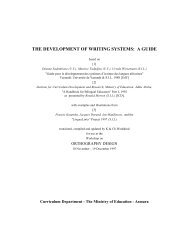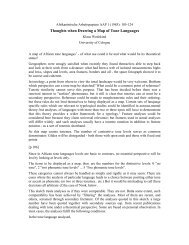1996 Review of Bender "Kunama" - Klaus Wedekind
1996 Review of Bender "Kunama" - Klaus Wedekind
1996 Review of Bender "Kunama" - Klaus Wedekind
You also want an ePaper? Increase the reach of your titles
YUMPU automatically turns print PDFs into web optimized ePapers that Google loves.
Kunama<br />
Lionel M. BENDER. <strong>1996</strong>. Languages <strong>of</strong> the World / Materials 59, 60 pp.<br />
LINCOMEUROPA, P. O. Box 1316, Unterschleissheim München, Germany<br />
Notes on Linguistics 80 (1998) pp. 27-30<br />
<strong>Review</strong>ed by JOHN ABRAHA and KLAUS WEDEKIND<br />
Ministry <strong>of</strong> Education, Asmara, Eritrea<br />
<strong>Bender</strong>'s work on Kunama is based on data gathered during visits in East Africa over<br />
the last 30 years. He specialized in East African languages as early as the 1960s, and<br />
from early lexico-statistic approaches to classification he kept on refining his methods<br />
with each <strong>of</strong> his numerous publications. As he now publishes a short monograph on one<br />
<strong>of</strong> the more intriguing Nilo-Saharan isolates, the comparatist and the theoretical linguist<br />
will peruse this brochure with heightened expectations.<br />
The brochure (only 50 AS-sized pages) does not disappoint these expectations. One<br />
reason for this is that <strong>Bender</strong> writes a rather compressed style, piling up considerable<br />
infonnation in every phrase: employing mphl. & synt. abbrs. whrvr. pssbl. In spite <strong>of</strong><br />
this brevity, his presentation <strong>of</strong> linguistic findings remains inviting, and a few passages<br />
are spiced with glances <strong>of</strong> theoretical perspectives (references to universals, x over x<br />
marking, grammaticalization). In general, however. <strong>Bender</strong> follows conventional<br />
patterns-which makes his work comfortable for readers who are looking for particular<br />
data 'about the language: The phonology is introduced with a grid <strong>of</strong> traditional features,<br />
and the morphology guides the reader along with traditional categories: 1 nouns, 2 preor<br />
postpositions or case, 3 demonstratives, 4 adjectives,S pronominals, 6 conjunctions, 7<br />
adverbs and inteIjections, 8 verbs.<br />
The central section covers nearly 60 percent <strong>of</strong> the booklet and is dedicated to the<br />
morphology (section 3), the most fascinating aspect <strong>of</strong> this language, given the<br />
nuinerous 'special' Kunama features. The rest <strong>of</strong> the brochure is dedicated to first (1)<br />
introduction and (2) phonology-then (4) syntax and (5) texts-ca. 10 percent each. One<br />
might have liked to fmd more on syntax and text structures. (The reviewers-engaged in<br />
dialect surveys and orthography studies-had hoped to fmd more about dialect and<br />
phonology issues), but given the 30 years <strong>of</strong> war between Ethiopia and Eritrea (Kunama<br />
straddles the border between both), it would be unfair to complain about the absence <strong>of</strong><br />
such information in a brochure <strong>of</strong> this series.<br />
The introduction <strong>of</strong>fers a weighted review <strong>of</strong> the literature. One 'unpublished' but<br />
important work is missing, even though <strong>Bender</strong> was acquainted with its author:<br />
'Sentence structure <strong>of</strong>Kunama', a thesis <strong>of</strong> about 120 pages written in 1987 by the late<br />
Nikodemos Idris-himself a Kunama.<br />
Its unique value lies in the balanced reviews <strong>of</strong> contradictory claims made by foreigners,<br />
and in the rich illustration <strong>of</strong>NP and VP structures.<br />
With the classification <strong>of</strong> this extraordinary Nilo-Saharan language <strong>Bender</strong> comes to a<br />
strong and important point <strong>of</strong> the introduction. He rejects (with more words than<br />
necessary) speculations about links with Omotic or Basque. Given his rich experience in<br />
matters Nilo-Saharan and given his fresh evidence (<strong>of</strong> which he publishes few but<br />
strong morphological and other isoglosses (especially p. 5», he adds much strength to<br />
the claims in earlier publications. The conclusion? <strong>Bender</strong> now places Kunama as
'coordinate with' Maba, For, Central Sudanic, Berta, and 'Core' Nilo-Saharan.<br />
The phonology <strong>of</strong> Kunama is so straightforward that <strong>Bender</strong> considers it 'bland' (before<br />
he touches on 'suprasegmentals'). A Nilo-Saharan language with eng or enye as the only<br />
'marked' segments is remarkably simple indeed. <strong>Bender</strong> likes to speak <strong>of</strong> an 'Ethiopian<br />
language area' (ignoring the flaws <strong>of</strong> this fuzzy generalization). Certainly Kunama<br />
cannot be considered part <strong>of</strong> such an 'area' if that would imply (a) rich sets <strong>of</strong> ejectives<br />
(Semitic), (b) implosives (Cushitic), or retr<strong>of</strong>lexes (Omotic): Kunama has none <strong>of</strong> these!<br />
Likewise when compared with Nilo-Saharan wealth <strong>of</strong> interdentals or vowels (except<br />
for 'Taguda' (see Nikodemos 1987), Kunama is different.<br />
It is a peculiar tradition <strong>of</strong> East African comparativists to shun tone analysis. For this<br />
Nilo-Saharan language, however, <strong>Bender</strong> does include many remarks about tone and he<br />
(somewhat over-cautiously) even considers both tone and stress contrastive. The<br />
transcription <strong>of</strong>ten shows tone, <strong>of</strong>ten stress, <strong>of</strong>ten both; unfortunately this leaves all<br />
unmarked data doubly ambiguous.<br />
In the morphology, there are several fascinating remarks which transcend the<br />
presentation <strong>of</strong> data, e.g.:<br />
As is cross-linguistically usual, when both d.o. and i.o. are present, i.o. takes precedence in<br />
marking [po l4]-many [postpositions] are clearly linked to nominals, e.g., body-parts (a subject<br />
which has become popular in linguistic circles lately as part <strong>of</strong> 'grammaticalization) [po 14]. The<br />
category <strong>of</strong>f] conjunctions overlaps with postpositions and adverbs and also bears on syntactic<br />
structures such as subordination. I think some [enclitics vs. postpositions vs. self-standing words]<br />
are further along toward becoming case-markers than others [po 23].<br />
Walking along <strong>Bender</strong>'s gallery <strong>of</strong> traditional word classes, we meet some eye-catching<br />
portraits:<br />
Articles: There are no articles in Kunama.<br />
So how does Kunama take care <strong>of</strong> definiteness? Nikodemos emphasizes the role <strong>of</strong><br />
demonstratives, and John Abraha analyzes -ella/e as indefinite article.<br />
Adjectives: Setting up adjectives as a category is questionable, [they have the] same shapes as<br />
nouns, [they] stand alone in nominal slots...<br />
Pronouns: Kunama is one <strong>of</strong> the minority <strong>of</strong> N-S languages having an inclusive-exclusive<br />
distinction [... it] has the most developed such system, having also dual person, found otherwise<br />
only in a trace in Nyimang <strong>of</strong> East Sudanic [po 17].<br />
<strong>Bender</strong> then presents the person-number system according to the categories speaker and<br />
hearer inclusion (S, II) [po 18] in a way which highlights formatives like dual= long<br />
vowel, non-singular=m, K=+H+S etc.) and which shows how b in aba T is special not<br />
only in the Kuanam system, but 'unique in Nilo-Saharan'. We have added Barka data in<br />
brackets [ ] where they differ from Marda. Barka compensates vowel length by<br />
consonant length.<br />
+Speaker<br />
-Speaker<br />
+Hearer - - ena 2 sg.<br />
kiime [kimme] 1 du.in. eeme [emme] 2 du.<br />
kiime 1 pl.in. eme 2 pl.<br />
-Hearer aba 1 sg. unu 3 sg.<br />
aame [amme] 1 du.ex. iime [imme] 3 du.<br />
ame 1 pl.ex. ime 3 pl.<br />
Selectors: The complexity <strong>of</strong> the pronoun system (above) is compounded in a system <strong>of</strong><br />
'selectors', <strong>of</strong> which 121 are conceivable-the product <strong>of</strong> 11 subjects (see the 11 cells above)<br />
multiplied by 11 objects.
Verbs: The division into verbs with prefixes (P) vs. verbs with suffixes (S) is not the common<br />
Afro-Asiatic divide where P vs. S goes with aspects: In Kunama this is a 'division <strong>of</strong> verbs into<br />
two conjugational types' which is presented in some detail [op.24-28).<br />
The syntax section centers around a nostalgic presentation <strong>of</strong> nine 'Phrase Structure'<br />
rules and a few 'Transformation' rules. The strength <strong>of</strong> this presentation is that it does<br />
present a 'condensed' compilation <strong>of</strong> facts [p. 39]. <strong>Bender</strong> characterizes Kunama as<br />
'highly agglutinative', as SOV 'having postpositions', and close to Heine's 'type D' (p.<br />
39).<br />
There are two short texts. Unfortunately the texts and their morpheme-bymorpheme<br />
translations are given in separate sections, which has allowed for some inconsistencies<br />
to creep in.<br />
The brochure is prepared carefully and the data are glossed accurately with only few<br />
exceptions (e.g., on pp. 7-8, gooda should be glossed 'sitting', and oikeda 'opening'). The<br />
tonal analysis is still lacking but any future dictionary must certainly include tone.<br />
Contrary to the statement in the brochure, no dictionary will be published by <strong>Bender</strong> in<br />
the near future, nor does Alexander Naty seem to have the time to do so. However, the<br />
Eritrean Ministry <strong>of</strong> Education is committed to publish reference works for all Eritrean<br />
languages, and this will include dictionaries. In spite <strong>of</strong> its small size, the booklet has a<br />
huge amount <strong>of</strong> data and fresh insights to <strong>of</strong>fer. It is a worthwhile acquisition even for<br />
linguists not intensely involved with NiloSaharan - e.g. as an example <strong>of</strong> how to write a<br />
rich morphology and how to present a grammar utilizing the strengths <strong>of</strong> various models<br />
eclectically. The Curriculum staff <strong>of</strong> the Eritrean Ministry <strong>of</strong> Education consider<br />
themselves fortunate that this grammar has appeared now as they are writing<br />
pedagogical grammars for the Kunama schools.<br />
[John Abraha, Min. Education, Curriculum and Research Dept., POB 1056, Asmara, Eritrea.]<br />
[<strong>Klaus</strong> <strong>Wedekind</strong>, Min. Education, DGE, Asmara, Eritrea. E-mail: <strong>Klaus</strong>@SIL.eol.punchdown.org]












